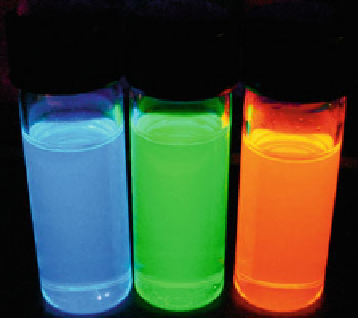Biomedical Engineering Reference
In-Depth Information
6.4 Semiconductor Nanoparticles
The most common syntheses of semiconductor nanocrystals such as CdS, CdSe,
CdTe, or CdSe/ZnS, ZnS, ZnO etc. have been carried out in organic solvents at
high temperatures in the presence of surfactants to yield monodisperse and stable
particles. This leads to the production of surfactant-coated particles. Here, the
polar surfactant head group is attached to the inorganic surface and the hydro-
phobic chain protrudes into the organic solvent, mediating colloidal stability. The
solvents used for the dispersion of these particles (e.g., toluene or chloroform) are
not soluble in aqueous media because of their hydrophobic surface layer. For
biomedical applications, water-soluble materials are required. Thus, the surfactant
layer is replaced or coated by an additional layer that introduces either an electric
charge or hydrophilic polymers for mediating solubility in water. Coulomb
repulsion between nanocrystals with surface charge of the same polarity prevents
aggregation in water.
6.4.1 Non-Oxide Semiconductors
Non-oxide semiconductor nanoparticles include a wide range of nanoparticles such
as cadmium chalcogenides (CdE, where E
sulfide, selenide, and telluride). CdE
nanocrystals were probably the first material used to demonstrate quantum size
effects corresponding to a change in the electronic structure with size, i.e., the
increase of the band gap energy with the decrease in size of particles. For example,
cadmium selenide (CdSe) QDs dissolved in toluene fluoresce in three noticeably
different colors (blue ~481 nm, green ~520 nm, and orange ~612 nm), (as shown in
Fig.
17
) because the QD bandgap (and thus the wavelength of emitted light)
depends strongly on the particle size; the smaller the dot, the shorter the emitted
wavelength of light. Hence, it is evident that the “blue” QDs have the smallest
particle size, while the “green” dots are slightly larger, and the “orange” dots are the
¼
Fig. 17 Cadmium selenide
QDs, dissolved in toluene,
fluorescing brightly in the
presence of a ultraviolet
lamp, in three noticeably
different colors (
blue
~481 nm,
green
~520 nm, and
orange
~612 nm). The
blue
QDs have the smallest
particle size, the
green
dots
are slightly larger, and the
orange
dots are the largest.
(Adapted from
http://www.

